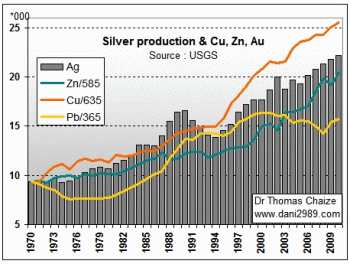
World production of the gray precious metal rose again in 2010. Silver, unlike gold, has seen production levels increase since 2003. This difference in production between gold and silver is not a coincidence due to geology and the history of their production.
World production of silver in 2010 was 713 million ounces. Silver production increased by 1.8% since 2009, 59.7% since its low in 1994 and 161.9% since 1968. In comparison, gold production increased by 8.7% since 1994 and 70% since 1968. World production of silver in 2010 has naturally increased with the increase in the combined production of copper, zinc and gold. This increase has resulted, somewhat mechanically, from the increased production of other metals around the world. Over two thirds of the production of silver is not from primary silver mines but from mine bi-products that produce zinc, copper, lead and gold.
World production of silver by country.
In 2010 Peru remains the world’s number one producer of silver. Silver production in Peru was 123.7 million ounces this past year, down by 1.3% when compared to 2009. The main silver mine in Peru produced 14.9 million ounces (12% of silver production in Peru). The mine is a primary copper mine which also produces silver. The second largest silver mine in Peru produced 10 million ounces (8% of silver production in Peru) and the third 8.6 million ounces (7% of silver production in Peru). The first three mines produce a quarter of the country’s silver, the rest is supplied by more than 140 mines.
Mexico is the second largest producer of silver in 2010. Production declined slightly from 114.1 to 112.5 million ounces of silver. The first number one mine in Mexico produced 35.9 million ounces of silver in 2010, one third of the country’s production and 5% of world production of silver in 2010. This mine is the second biggest silver mine in the world and also produces gold, lead and zinc.
China, number one in zinc, lead and gold, is the third largest producer of silver. China’s silver production continues to grow in 2010, up from 93.2 to 96.4 million ounces of silver. The largest silver mine in China (limited information available so no assurances on this data) is also a wealth of zinc and lead and accounts for only 4-5% of national production and 0.6% of world production.
Australia, number two in lead and gold, is the fourth largest producer of silver with 54.6 million ounces produced in 2010. Australia has the largest silver mine in the world. The mine also produces zinc and lead but is primarily a silver mine. Australia’s largest silver mine produces two thirds of the silver the country and accounts for 5.2% of world production of silver.
Chile, number one in copper, is the fifth largest producer of silver with 48 million ounces of silver produced in 2010. The leading silver mine in the country is also the world’s largest producer of copper, it extracts a quarter of silver production in Chile.
Russia is the sixth largest producer of silver in the world with 45 million ounces of silver produced in 2010. One third comes from a single mine that also produces gold with silver.
Bolivia is the seventh largest producer of silver with 43.7 million ounces of silver in 2010. The main silver mine in Bolivia produced 6.7 million ounces of silver in 2010.
The USA ranks eighth in silver production with 41.1 million ounces of silver produced in 2010. The largest U.S. silver mine, located in Alaska, is also the eighth largest silver mine in the world. It represents 17% of the silver from the U.S. and also produces zinc and lead.
Poland is the 9th largest producer of silver with 38.5 million ounces of silver. 100 percent of Polish production comes from from one mine that also produces copper.

Of these nine countries, the only leading silver mine that produces exclusively silver is from Bolivia. For all the other top silver producing countries, the largest silver mine also produces either copper, zinc, lead, molybdenum or gold.
As noted above, two-thirds of silver production is not derived from primary silver mines, rather from mine bi-products that produce silver along with copper, zinc, gold, lead, molybdenum, or even uranium (in Australia).
It is for this reason that the future of silver production depends to a large degree, almost half, on the production of zinc and copper. While the price of silver is often put in parallel with that of gold, its production depends primarily on the production of base metals. Therefore, the peak production of silver will probably happen at the same time as copper and zinc.
From the article entitled, “World Production of Silver” by Dr. Thomas Chaize author of the Mining and Energy Newsletter. The information provided herein has been provided to MiningFeeds.com by the author and, as such, is subject to our disclaimer: CLICK HERE.




 Follow us on Twitter
Follow us on Twitter Become our facebook fan
Become our facebook fan











Comments are closed.